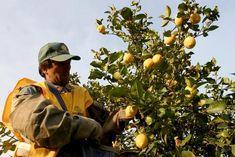
Argentina leads the field when it comes to exports of southern hemisphere lemons. And 40 per cent of total Argentinean lemon exports are produced by San Miguel, with a volume of six million boxes annually.
The grower-exporter is celebrating its 50th anniversary this year, and now boasts some 5,600 hectares under production in Argentina’s north-western Tucumán province.
The company’s association with the UK dates back more than 10 years, and in that time it has established close relationships with major importers, supermarket chains, wholesalers and caterers.
As a company, San Miguel has been developing beyond its primary interest in lemons and it also produces oranges in Tucumán. It has also acquired significant interests in Uruguayan citrus, most notably with the take-over of Milagro and a 33 per cent share in Caputto. In the late 1990s and early this decade, San Miguel branched out with acquisitions of companies in production of non-citrus lines such as stonefruit and grape. However, it has returned to its core focus of citrus and in 2003 acquired two further citrus companies Terfrusa and Zephir in Uruguay.
San Miguel exports around the world to the Middle and Far East as well as every country in the European Union and most of eastern Europe. It also has a strong market presence in many former Soviet republics, Canada and significantly in Japan since last year. In fact, San Miguel heads up an Argentinean lemon export consortium established for the Japanese market to handle fresh sendings.
However, the UK is undeniably a key and sophisticated market and one that the company still believes has potential for yet more growth. Argentina has the second largest share of the UK lemon market behind Spain and San Miguel already holds a 60 per cent portion of all Argentinean lemon exports to the UK. “We believe that it is possible to grow the UK market for lemons as the per capita consumption is low compared to similar markets, for example the Mediterranean countries in the EU,” explains Adolfo Storni, commercial manager at San Miguel.
“There is potential to grow the market for both culinary uses and drinks. Catering will take a key role in future growth. We have to educate consumers about the benefits of our lemons. Immigration, ethnic foods and eating out are also helping the trend.”
Year-on-year growth of San Miguel lemon exports to the UK is running at about 10 per cent and the company is also segmenting the market and developing new products. “We are trying to generate more added value for example with un-waxed lemons, pre-packs, nets or value packs as well early and late variety innovation to extend the season,” says Storni. “We are following consumer trends and the drive for different uses of lemons is increasing.”
Storni also believes that despite European production of lemons still being available year-round, there is an opportunity for San Miguel to extend its season, as the trend for European summer lemons is a declining one. “Argentina is the clear market leader in southern hemisphere lemons and what we are trying to do is replace some of the European production,” he says.
“European summer lemons are on the decline and it is always better to have a fresh, juicy, recently harvested lemon than one that is hard, or low on juice content or has been stored for a long time. That is where we see the opportunity to extend our season,” Storni concludes.



